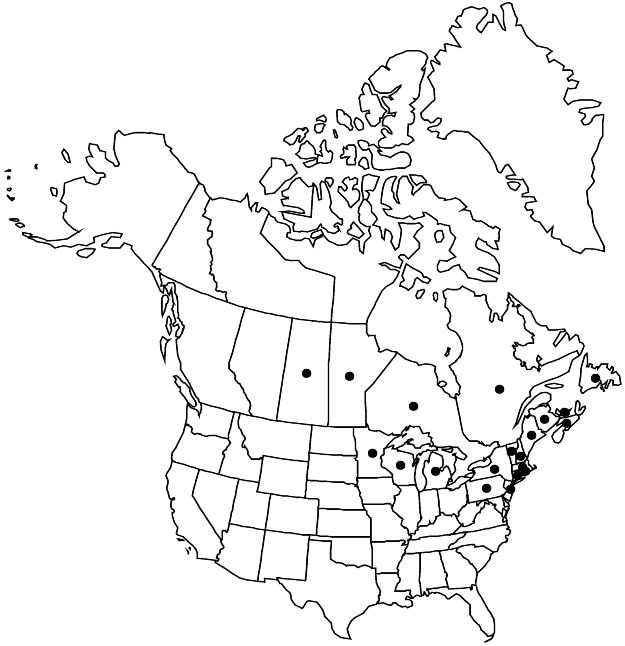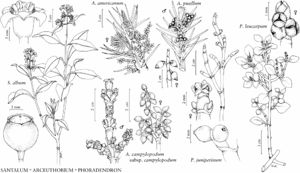Arceuthobium pusillum
Trans. Albany Inst. 7: 191. 1872.
Plants forming systemic witches' brooms. Stems green, orange, red, maroon, or brown; secondary branching (rarely seen) fanlike, branches 1(–3) cm, third internode 1–1.9 × 0.5–1.5 mm; dominant shoot 1 mm diam. at base; pistillate stems usually longer than staminate. Staminate pedicels absent. Staminate flowers radially symmetric, 1 terminating stem or 3 in dichasium, terminal subglobose in bud, lateral lenticular in bud, 1.7–2.2 mm diam.; petals (2–)3(–4), red to maroon. Berries proximally green, distally yellowish to reddish brown, 3 × 1.3–1.8 mm. Seeds pyriform to elliptic, 1.4–1.8 × 1–1.4 mm, endosperm bright green. 2n = 28.
Phenology: Flowering (Mar–)Apr–May(–Jun); fruiting Sep–Oct.
Habitat: Spruce forests within 500 m of coast and inland bogs, often within 2 km of lakes and rivers.
Elevation: 0–800 m.
Distribution

Man., N.B., Nfld. and Labr. (Nfld.), N.S., Ont., P.E.I., Que., Sask., Conn., Maine, Mass., Mich., Minn., N.H., N.J., N.Y., Pa., R.I., Vt., Wis.
Discussion
Staminate meiosis occurs in September, pistillate meiosis in May, with fruits maturing five months after pollination; seeds germinate in May to June.
In 1858, Thoreau wrote about the witches’ brooms of Eastern dwarf mistletoe, over a decade before the species was actually described. Lucy B. Millington of Warrensburg, New York, recognized the mistletoe in 1871 and related her discovery via correspondence with C. H. Peck, who named the species in the following year (B. S. Smith 1992). The species was later found to be widespread in spruce forests throughout the Great Lakes states.
Arceuthobium minutum Engelmann, which pertains here, was published in 1871 but without a description, hence it is invalid.
Arceuthobium pusillum forms massive systemic witches’ brooms that severely affect the vigor of its principal host, Picea mariana (black spruce). White spruce (P. glauca) and red spruce (P. rubens) are less commonly infected. Occasional to rare hosts include Abies balsamea, Larix laricina, Pinus banksiana, P. resinosa, and P. strobus. Molecular phylogenetic work revealed that Arceuthobium pusillum is most closely related to A. bicarinatum Urban of Hispaniola (D. L. Nickrent et al. 2004). Given that these two species differ greatly in size, this result demonstrates the dramatic morphologic changes that ancestors of A. pusillum underwent, possibly as adaptations to cold climates.
Selected References
None.
